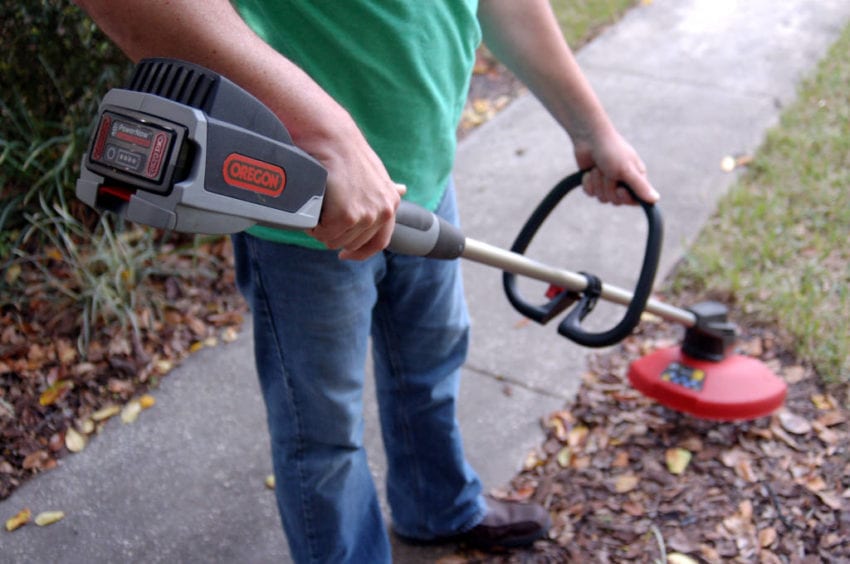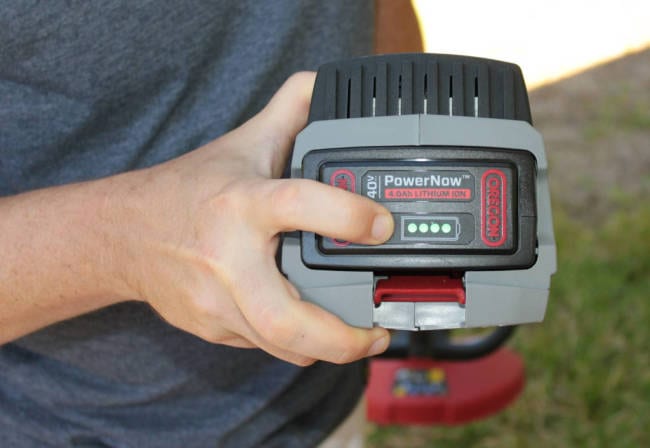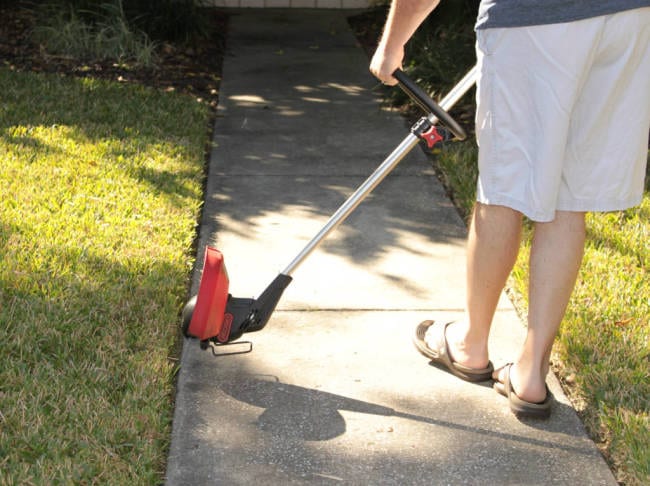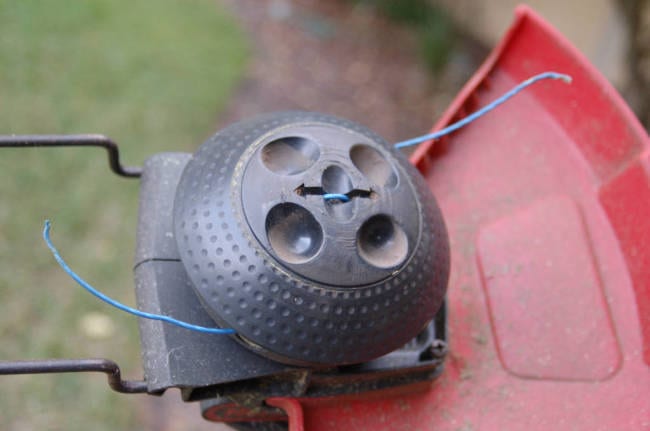Having recently reviewed Oregon’s PS250 Pole Saw, which resulted in high marks; I was excited to seize the opportunity to review the Oregon ST275 Trimmer/Edger . Since Oregon products can only be found in smaller, professional equipment dealer locations, I assume that most, if not all, homeowners and a large number of pros may not be familiar with the Oregon line-up of 40V power tools. I’m here to give you a virtual tour and reasons to consider the Oregon ST275 Trimmer/Edger.
After many years of buying consumer-grade gas powered yard equipment, I became frustrated with the clogged carburetors, fuel mixing, difficult starts and noisy operation. While I don’t mind doing yard work, I do mind having to be a small engine mechanic, since I am not qualified to be one, nor do I have the time to learn.
Unpacking and assembling the Oregon ST275 was simple. All that was required was the trim guard and handle attachment. Packaging was simple and effective which gave me the positive impression that Oregon focuses their talents on the equipment and less on package glitz.
The 40-volt PowerNow Lithium Ion battery installs quickly and positively. A nice feature of the battery is the 4 light charge status, which indicates the level with the press of a button. Starting the trimmer/edger was as simple as a simultaneous squeeze of both the release and trigger. This combination switching was easily accomplished with one hand. I’m sure I speak for most gas-powered users that starting equipment is at the high end of the “I hate this” list. Fortunately, Oregon provides a no shoulder straining, no fuel priming, and no choke to fuss with experience. The 4.0 Ah battery came fully charged in my case, so getting to work was quick and easy.
I have high expectations for clean edging at plant beds and hard edges like the driveway and sidewalk. Additionally, my fence line is a challenge due to the cutting-line killing surfaces of skewed fence boards, unruly grasses and wind blown objects, which find shelter along the perimeter of my property. The alternating process to trim or edge is simply a turn of the unit to either vertical or horizontal line direction, respectively. While some all-in-one trimmer/edger tools have rotating click-lock heads and handles, Oregon kept it simple… Just rotate the whole tool – easy, simple and quick.
When it comes to power control, the Oregon ST275 provides a variable speed trigger. This may sound like it should be standard equipment, but compared to others in the cordless category, it isn’t. Having the ability to control speed may not seem like a necessary feature, however, it is essential when you’re close to those prized flowers or backyard speaker wires you intended to bury but haven’t gotten around to yet.
Line advancement follows the convention of bump and go. I found that it took a pretty good bump to feed the line. Once I got used to the added pressure required to advance the line, I felt that the system was more robust and durable compared with others I’ve used in the past. Time will tell if my hypothesis comes to fruition, however, it made a good first impression to say the least.
The dual line makes quick work of anything in its path. I’ve got southern grass which some would liken to green hay, but it didn’t phase the Oregon ST275. When full power was thrown while trimming, it chewed through the sinewy ground cover like nobody’s business. I actually found myself a little intimidated near a particularly jungle-like pile of grasses and weeds I had neglected for weeks with my 20-volt trimmer. As I started into the patch, it devoured the mess a lot faster than I had expected.
Swinging the edger guide into position is easy and provides for a pretty good edge-guiding surface. It took a little getting used to, as I’ve never encountered an edging system of this type. Most have a wheel with a metal flashing which guides the tool against an edge, or some variety of similar solutions. In Oregon’s case, the edge guide reminds me of what other trimmers would use as a flower guard. You know – the flip down wire “U” that is slightly longer than the trimmer line? At first, I was skeptical of this design simply because I didn’t think it would work. That said, once I gave it a chance, it proved to be effective. I began to think that Oregon really was thinking outside the box with their trimmer/edger. It took a little practice to optimize the edge appearance, as the edging mode is as aggressive as the trimming mode. Once I got a feel for it and let the tool do the work, it started looking pretty good. As with most quality tools, most problems are due to operator error or inexperience.
As with all tools like this, the line or string (whatever you’d like to call it) eventually has to be refilled. This would be the second hassle that makes it to the top of the “I hate this” list. My experience with other heads include the unscrewing of the bump knob, removal of the spool, winding line (worse if its dual), and assembling it all while trying to keep the coiled line from springing loose. In the past, I’ve seriously considered replacing the whole tool to avoid having to deal with this physics project.
Fortunately, the Oregon ST275 has a clever quick load system, which eliminates the hassle of everything I just mentioned. While it’s still a manual procedure, it’s certainly a more efficient and positive way to reload string. Oregon’s procedure allows for a pull-through and wind-in procedure while onboard the head. Rather than a loose spool of material to fight with, the user would have a full length of string, mating the ends together, placing the ends in the respective holes and pulling all the line through the head. At that point, the string is wound-in by rotating the spool to take up the slack, which results in an easily loaded supply of string. The key benefit of this method is no disassembly of the head, as required by other manufacturers. This represents another example where Oregon has thought outside the box.
From a handling standpoint, this tool is pretty well balanced. I found it to be heavier than I’m used to, however, the trade-off in weight compared to my 20-volt unit was a tremendous increase in torque and cutting speed. I had a hard time keeping up to the pace of the Oregon, where I had to slow down my gate with the 20-volt unit. I can’t say that the Oregon cut my time in half, but it was markedly quicker than in the past with other cordless tools.
Once complete, the usage had barely affected the charge level on the battery. This is a very similar experience I had with the Oregon PS250 Pole Saw, so it’s good to know that the battery performance of the PowerNow 40 volt system is consistent between these two tools. On a side note, having had the pole saw battery in standby for a couple of weeks, it was unchanged at a 3 out of 4 power level. This is good news for people who don’t use their cordless tools every day. As Oregon advertises, their tools are ALWAYS READY™.
As with the Oregon Pole Saw PS250, my overall experience with the Oregon ST275 Trimmer/Edger was very positive. For those looking for a robust and ready-when-you-are solution to yard work, this is the product for you. My experience has taught me that with most tools, “the simpler solutions to get the job done, the better” as well as “you get what you pay for”. This trimmer/edger fits the bill on both of these philosophies. While the Oregon ST275 isn’t the cheapest of the brands, it definitely is value priced compared to its competition.
Since the brand is only sold through authorized online and smaller dealers, it suggests some exclusivity by straying from the big box retailers. In an age of big commercial names “dumbing down” their equipment to reach the general consumer, Oregon appears to be holding the line on their commitment to pro-level solutions. I would recommend the Oregon ST275 to small landowners who appreciate great quality and value, as well as larger landowners who need dependability and extended run-time for large lots and extended trimming and edging surfaces.
I encourage readers to explore and seriously consider this line of equipment by visiting Oregon’s website to find a local dealer or to visit their authorized online retailers.






